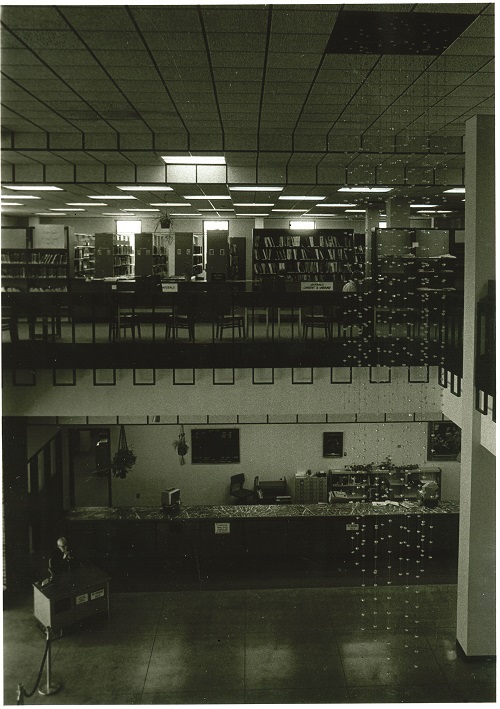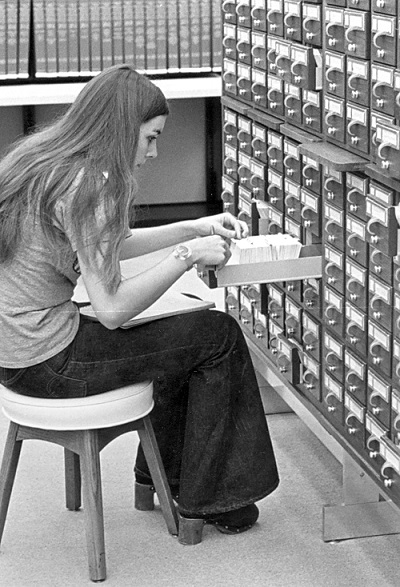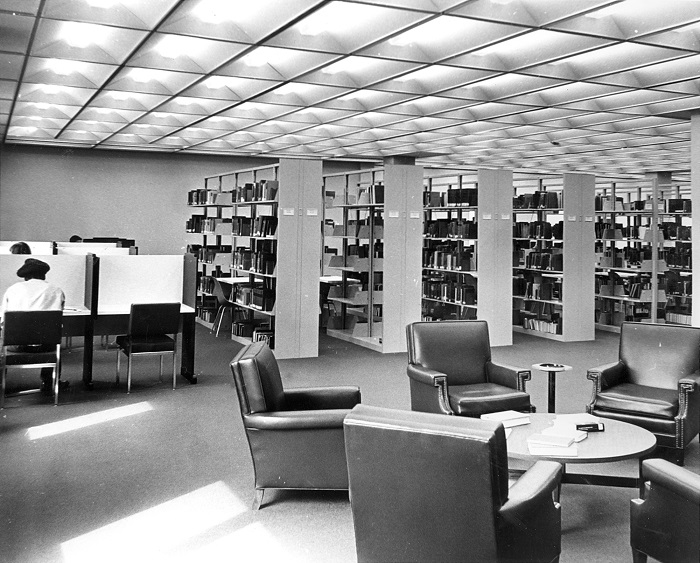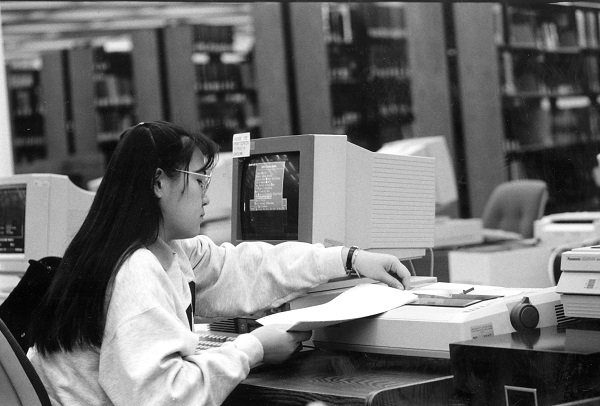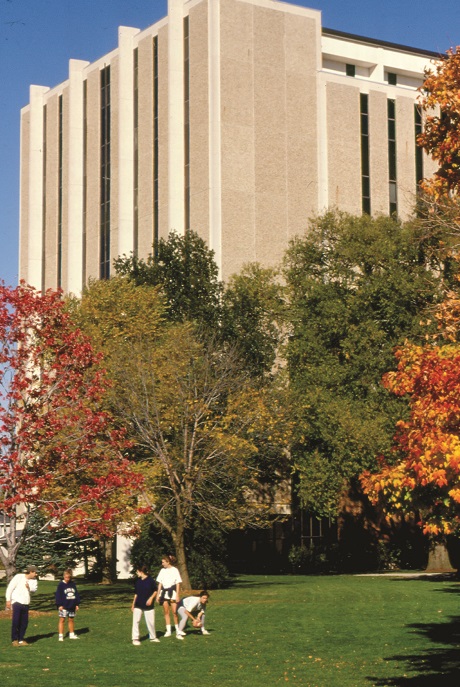University Libraries
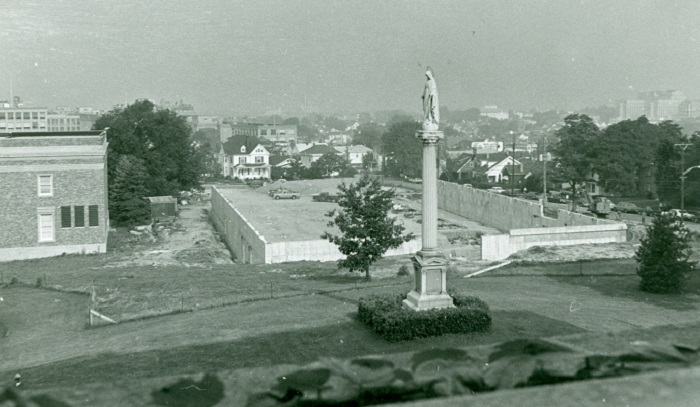
A Brief History of the University Libraries
By Kathleen Tiller
Ideas of what libraries look like and what happens behind their walls have been ongoing probably since the ancient Library of Alexandria opened its doors to scholars and thinkers 2,300 years ago. Libraries worldwide have undergone massive and sometimes startling changes. The University of Dayton’s newly renovated Roesch Library might stir up fond memories of the good old days or present a whole new image of what a library has to offer. One thing is for certain: The current library is vastly different from the one St. Mary’s Institute students used during the 1860s.
Spartan beginnings
UD libraries’ beginnings mirrored the humble start of many college libraries in colonial America. With a fixed classical curriculum, an institution would have little need initially for more than standard texts and religious or philosophical treatises. When St. Mary’s School for Boys in Dayton opened its doors to 14 students in 1850, any library probably consisted of books owned by the Marianist brothers. Those books formed the initial library in a corner of St. Mary’s Hall.
UD’s early history gives scant mention of a library. One 1866-67 circulation record detailed checked out titles, mostly for spiritual enrichment, but also for recreation. Twenty years later, the school’s 1887-88 catalog mentions a $1 charge for use of the library. Few references to a library, however, did not mean a lack of attention to a need for one. In 1897, a report mentioned the demand for an additional library case. December 1903 plans for the enlargement of the college brought up “a library, reading, and assembly room” as necessary additions.
The building of Chaminade Hall in 1904 provided that needed space, adding a Faculty Library of about 3,000 volumes, as well as magazines and newspapers in the Brothers’ Study Room. The First Division Study Hall contained a smaller collection for students. By 1909, the basement of Chaminade was home to a “commodious” Zehler Library, named after Brother Maximin Zehler, S.M.
A gift for what was needed most
Shortly after World War I, the need for a larger facility became apparent. Father Bernard J. O’Reilly, UD’s president at the time, approached Victor Emanuel, a former preparatory student, for a donation to build one; however, Emanuel’s main interest was athletics. When asked by Brother William J. Wohlleben, S.M., founder of the chemistry department and one of Emanuel’s favorite teachers, which he preferred — a new gym or a new library — Emanuel agreed to give the library since it was needed most. His donation of $200,000 for a new library to be named in memory of his father, Albert Emanuel, was a sizable sum at the time. Ground was broken in April 11, 1927, and the library opened in 1928. Designers made provisions such as storing unused bricks under the building’s portico for later expansions. The Dayton Daily News called it a “model of library efficiency.” Books were stored in a six-tiered well, the latest in modern book stack technology; a patron submitted a card with call numbers, and a student worker would retrieve the requested material. At the time of its dedication, the collection of 25,000 books facilitated accreditation with the North Central Association of Colleges and Schools.
Within 10 years, the need for more stack space became obvious yet again. In 1965, Father Raymond A. Roesch, S.M., the University’s president, decided the time had come for an addition to Albert Emanuel, along with open shelving for books and journals; additional reading space; and total book capacity of 300,000 volumes. By 1969, the library building was inadequate to serve a student population of 10,000. This pointed to one solution: a whole new building.
Eight floors … and an eye to the future
Initial plans took shape for eight floors for future horizontal and vertical expansion. The challenges posed were many. Comfortably accommodating 2,500 students and faculty at any one time and mixing people with books in an atmosphere departing from traditional absolute quiet were first on the list. The library had to meet University needs through 1980 plus any foreseeable advancements in electronic techniques for storing and accessing the collection. The library, the planners said, should be a place for more than formal classroom learning, that is, a place for faculty and students to actually meet and share ideas. Smoking, matched with adequate ventilation, would be allowed on each floor and in every group study room. The structure needed to be highly visible and proximal to present and future academic buildings.
Most faculty applauded the plan; however, some opposition arose. Closing two science departmental libraries — the Wohlleben Library for chemistry and geology and the Sherman Library for physics and the life sciences — met vocal resistance, with some faculty objecting to the inconvenience of walking to a different building. Ultimately, centralizing prevailed.
A blessed beginning
Architects and engineers from Pretzinger & Pretzinger and library consultants James V. Jones and Associates of Cleveland designed the $4.8 million library as a “graceful structure of concrete panels with exposed aggregate and brick.” Groundbreaking took place March 26, 1969, with the same chrome-plated ceremonial shovel used 14 other times for UD buildings. Brother Raymond Nartker, S.M., library director during the construction and the move from Albert Emanuel, turned over the first spadeful of soil. Brother Frank Ruhlman, S.M., who had presided over the groundbreaking for Albert Emanuel Library 40 years earlier, was present for the ceremony.
Before the library could officially open, the major hurdle was the physical move of the Sherman, Wohlleben and Albert Emanuel collections. The lowest bid from a moving company was $15,000. Students in a plant layout class in UD’s Technical Institute, in a detailed 45-page plan for moving the books, determined that the movement and consolidation of books could be performed by the University community for less than half that amount. Five students tackled the problems of specifying the tasks of box loaders and unloaders, elevator operators, and material handlers to be completed over five days. Books were placed in beer cases donated by the Schoenling Brewing Co. of Cincinnati. Approximately 45 students moved the books from Albert Emanuel through the tunnel connecting old and new buildings.
Modern features, inviting design
The new library was completed January 23, 1971, at a total cost of $4,780,332.84 including landscaping. Problems encountered along the way were minor. A crystal chandelier, for instance, custom-designed to hang from the second-floor ceiling above the lobby, suffered some hardly noticeable breakage of the middle string’s upper section during shipping. The library's design achieved an atmosphere of people mixing with books rather than an intimidating silence of long rows of shelving.
Walt McCaslin of the Journal Herald, a daily newspaper in Dayton, was more critical of the new building, calling it boxy and saying the style imitated too many of the structures that had appeared throughout the Dayton area since the appearance of more sensitively designed nearby NCR buildings. McCaslin did, however, note that the library had a serene atmosphere conducive to work.
In 1979, it finally received the name of “Raymond A. Roesch, S.M., Library.”
More changes to Roesch Library continued over the years. The School of Law moved into Albert Emanuel Hall, and the law library took over the new library’s ground floor. The iconic card catalog with its numerous drawers gave way to terminals to access the online catalog. Current periodicals, once accessible from a restricted area only by request from the librarian on duty, moved to open stacks for anyone to use. Access to scholarly literature has gone from shelves and shelves of bound periodicals and indexes to electronic databases and sometimes open access. The law library moved once more to a new building, Keller Hall, and the empty space was dedicated as the Ryan C. Harris Learning Teaching Center, a laboratory for innovation in learning and teaching. The reference room morphed from a simple desk, print periodical indexes, and typical reference books to an inviting, eye-level service desk staffed by librarians and student aides. The pared-down reference collection opened up space for the Write Place, which offers peer support at any stage of the writing process. The 1967 directive to supply adequate pencil sharpeners throughout the building was replaced with an imperative for enough wireless access points and electrical outlets for students’ laptops and other devices. Vending machines and food deliveries replaced the strict “no food” policy. Even the outside of the library received a new coat of many bricks and scholarly-looking pillars.
Technology, teaching, research advance
Some undated “predictions” have come true since Roesch Library opened its doors in 1971. The library had been planned with computerized services in mind. A statewide system envisioned to link library catalogs and share materials became OhioLINK. Retrieving books and the full text of journal articles electronically is no longer just a possibility, but an essential part of the research process taught to first-year students.
And in August 2019, a two-year renovation called “Roesch Refresh” aligned elements of the Libraries’ and the University’s strategic plans with the latest in the design of library spaces and services. It features an open concept with flexible space for dynamic learning, research, and teaching. The first and second floors emphasize more consultation space. The current magazine and newspaper browsing area boasts a living room feel. The most obvious change is the emphasis on deliberate spaces for large or small groups. The expanded technology-enabled Collab, now on the second floor, offers a welcome environment for library instruction, group study, and team projects.
The room’s capability to accommodate different teaching styles and meetings with its multiple display screens and movable furniture is a perfect example of how the library has evolved since its rudimentary beginnings in that corner of St. Mary’s Hall.
Another blessed beginning
The newly reopened spaces in Roesch Library will receive a ceremonial blessing during an event from 3:30 to 5:30 p.m. Friday, Sept. 27, in the Gathering Place on the second floor.
'Reflections and Revitalization: The Story of UD Libraries'
Faculty and staff in the University Libraries have curated an exhibit of photographs and artifacts illustrating the history of the University Libraries. "Reflections and Revitalization: The Story of UD Libraries" will be on display Monday, Sept. 9, through Friday, Nov. 1, in the first-floor gallery. The public is welcome whenever Roesch Library is open.

